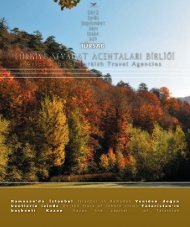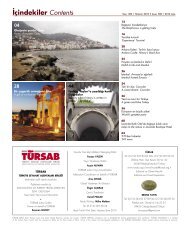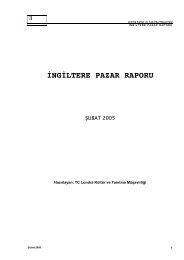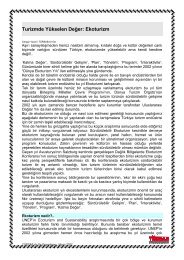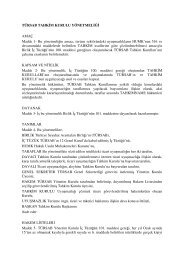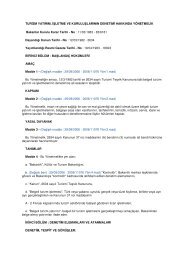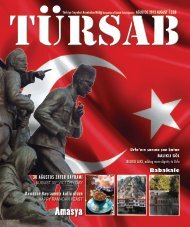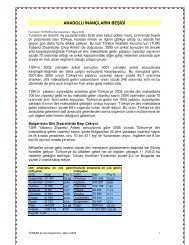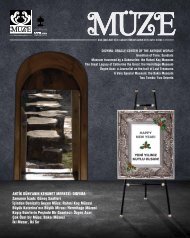kültürel zenginliğimiz onlara emanet - Türkiye Seyahat Acentaları ...
kültürel zenginliğimiz onlara emanet - Türkiye Seyahat Acentaları ...
kültürel zenginliğimiz onlara emanet - Türkiye Seyahat Acentaları ...
- No tags were found...
Create successful ePaper yourself
Turn your PDF publications into a flip-book with our unique Google optimized e-Paper software.
Sergi, akademik bir kadro ile konularınınönde gelen uzmanlarının oluşturduğubilimsel danışma komitesinindesteğiyle hazırlanmış.Bu anlamda, sanat tarihi yada sosyoloji öğrencileri içinders niteliğinde olduğunu dasöyleyebiliriz.Sergi ayrıca Oryantalizm’inbilim dünyası üzerindeki etkisindenDoğu’nunstili ve zengin kumaşlarından etkilenenBatı modasına, Batı mimarisindekiDoğu etkisindenarkeolojideki yansımalarınakadar pek çok konuya ışıktutuyor. Resim, arkeolojikeser, sahne kostümü, “Şarkiyat”konulu kitaplar vefotoğrafların yer aldığı sergikapsamında, Oryantalizm’inçeşitli açılardan inceleneceği konferans dizileri,film gösterimleri ve çocuk atölyeleri dedüzenleniyor. Sergi programından konferanstarihlerine göz atmayı da unutmayın. Batı’nınDoğu’yu bir bilgi ve sanat nesnesi olaraknasıl gördüğünü anlamak için bu sergiyikaçırmayın.Haremde Kadınlar ve Yaşlı Adam, 1883, Walter CharlesHorsley (1855-1921), Tuval üzerine yağlıboya, 97 x23 cm, Özel Koleksiyon (sol üstte). Ziyaret, Harem İçi,1860, Henriette Browne (1829-1901), Tuval üzerineyağlıboya, 109 x 158 cm, Özel Koleksiyon (sağ üstte).Rubaiyat, Ömer Hayyam, Edward Fitzgerald, 1942civarı, Özel Koleksiyon (sağda) ve Avrupa pazarı içinüretilmiş Doğu konulu dekoratif objeler, 19. yüzyıl(küçük resimler).Harem Women and the Old Man, 1883, Walter CharlesHorsley (1855-1921), Oil on canvas, 97 x 23 cm,private collection (top left).Visit, Harem Interior, 1860, Henriette Browne (1829-1901), Oil on canvas, 109 x 158 cm, Private Collection(top right). Rubaiyat of Omar Khayyam, EdwardFitzgerald, around 1942, Private Collection (right) andthe Orient on the decorative objects produced for theEuropean market, 19 th Century (thumbnails).42Orientalism is the common name given to all research areas devoted by Western civilizationsto the study of the cultures, languages and peoples of the Near-and-Far Easternsocieties. Although the concept was essentially generated in the 19 th Century as the nameof a field of research, it acquired a negative connotation following the publication in 1978of Palestinian-American thinker Edward Said’s book entitled “Orientalism”. Orientalismwas no longer accepted as the mere heading of a research area, but became a word characterizingthe biased attitude of the West vis-à-vis the East, frilled with a zest of ignorance.In the eyes of the West, the East is as poor as it is mystical, and as much lazy and fatalisticas it is mysterious. For the West, the East is a mere object of knowledge. The activesubject, thinking individual role is on the part of the West. Against the background of suchan evolution, the manifestations of Orientalism reflected in the area of art paved the wayto an all the more abundant production. Artists have always been quite attracted bythe theme of Orientalism. Sometimes an artist became an Orientalist unknowingly andwas made aware of that fact only when art critics qualified his/her production as such.And on the contrary, some artists who adopted Orientalism as their art direction andnourished themselves from that concept, authored productions which undermined Orientalismaltogether. Now, a new exhibitiondevoted to the theme at the Sakıp SabancıMuseum, places Orientalism once againunder the spotlight. While the exhibitionentitled “1001 Faces of Orientalism” focusesmainly on 19 th Century Orientalism, it shedslight at the same time on the impact of thetheme on many areas ranging from science,archaeology, architecture, fashion, photographyto World Fairs, by going down to theroot source of the term “Orientalism”.The archaeological excavations performedin Near Eastern countries at the beginningof the 19 th Century, images from World Fairs,examples of Ottoman buildings erected inthe Orientalist style of architecture initiallydeveloped in Europe, Orientalist styleinterior designs, stage designs and fashion,studio photos, and various stages of the“travel to the East” wave beginning with the19 th Century, are presented through variousobjects, samples and documents. Theexhibition was prepared with the support ofa scientific advisory committee composed ofa group of academics with leading experts in



